The Greek goddesses are elementary figures in ancient Greek mythology.
These extraordinary women are part of a set of characters that present stories full of symbologies.
In general, they are narratives about life and how to deal with different emotions, such as trust, fear, courage, jealousy and envy.
Furthermore, each goddess has a meaning and message to convey.
1. Aphrodite: Goddess of Beauty
Aphrodite is a goddess whose symbols are beauty, love and sex.
According to mythology, this divinity originated from the union between the sky and the sea. This is because the god Uranus (which represents the sky) had his genital organ cut off by Cronos (weather), and this one was thrown into the sea.
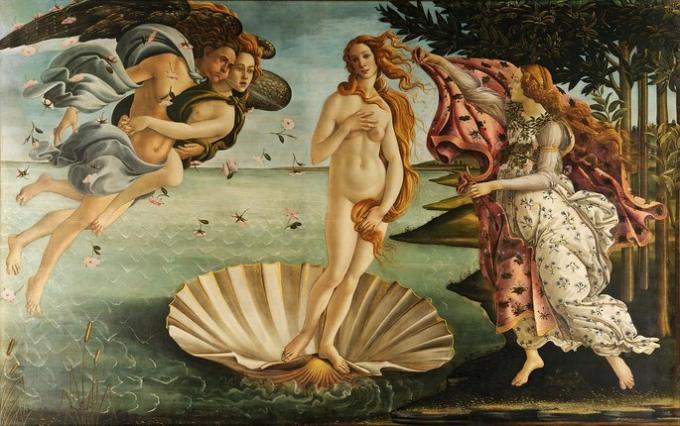
Then a foam formed in the waters from which Aphrodite emerged. That's why the meaning of her name is "from the foam".
She was a beautiful woman and left all the gods of Olympus enchanted with such perfection. Roman mythology named Aphrodite as Venus.
Learn more about the subject: Aphrodite, greek goddess.
2. Athena: Goddess of Wisdom and War
The goddess Athena has many attributes and is related to wisdom, art and creation. Furthermore her name is associated with war and justice.
The story tells that she was born from the head of her father, the mighty Zeus. He had swallowed his pregnant wife, for he knew through an oracle that the child would be born stronger than he was.
Then, after a while, Zeus got a terrible headache and asked Hephaestus to open his skull. From within him came the wise Athena.
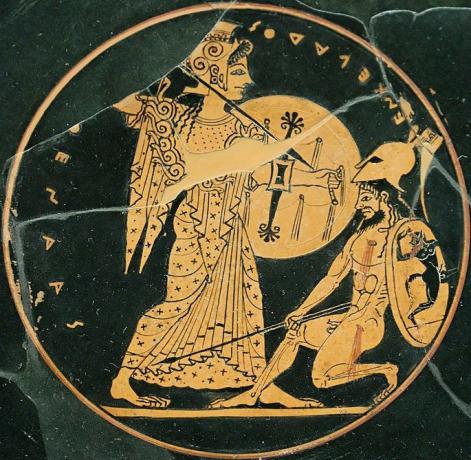
The goddess was a very beautiful and thoughtful girl. Her robes were armor and helmet and she had in her hands a shield with the image of Medusa, a mythological being that the hero Perseus killed.
This is a deity worshiped as the protector of cities, architects, goldsmiths and weavers. She takes the name of Minerva in Roman mythology.
Read too: greek goddess athena.
3. Demeter: Goddess of Fertility
Demeter is the goddess of fertile land, harvesting, agriculture and the seasons. She was responsible for teaching human beings to plant and that is why wheat is a panta dedicated to her.
Her parents were Cronos and Rhea. One of her brothers was Zeus, with whom she had a daughter, young Persephone.
Demeter was very shaken when her daughter was taken to hell by Hades. The seasons then stopped. Plants did not grow and there were shortages on Earth.
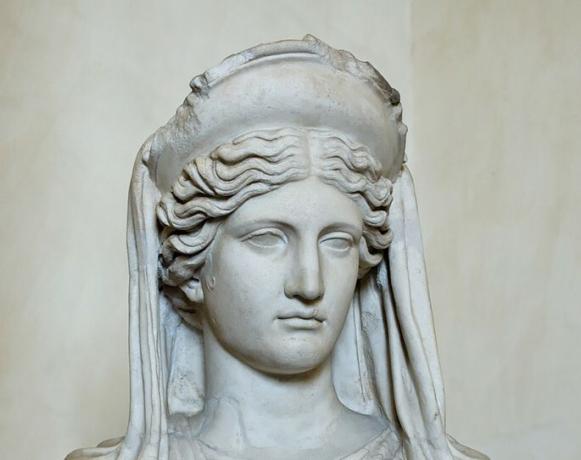
Through Zeus' interference, the daughter was allowed to stay with Demeter for a period of the year. So the seasons happened again.
The goddess is usually represented as a matriarch seated with a torch and her power animals are the snake and the pig. Ceres is his name for the Romans.
Know more: Demeter: goddess of agriculture.
4. Artemis: Goddess of the Hunt
Artemis is the deity of hunting, wildlife and the Moon. She was also a midwife, and that is why she protects young people and children.
Daughter of Zeus and Leto, she is the twin sister of Apollo. This god is related to sunlight, while Artemis is related to the lunar universe.

The mythology tells that her mother had a very difficult birth. The first to be born was Artemis, who, seeing her mother's suffering, helped her give birth to her brother Apollo.
Once, when asked by her father about her deepest desires, Artemis replied that she would just like to walk free in the woods and never marry.
So it was done, and she, having a strong and vindictive personality, killed those who challenged her, such as Actaeon, Orion and Agamenon.
This figure is always surrounded by wild animals, being her sacred animal bear. She carries a bow and several arrows and wears a short pleated robe.
Roman mythology gave the name of Diana to that goddess.
Go deeper into the subject by reading: goddess artemis.
5. Gaia: Earth Goddess
Gaia is the primordial Earth goddess. Its origin occurs when universal chaos meets order. So she is your mother and father, responsible for your own upbringing.

She is therefore the first Greek goddess. She generated the planet, nature, the seas and also the other gods, the first of her creations being the god Uranus, with whom she had other children.
This goddess is seen as a woman with a maternal appearance and a strong body, emerging from the earth.
Earth it's her name in Roman mythology.
6. Persephone: Goddess of the Underworld
The goddess Persephone is, along with her mother Demeter, the goddess of agriculture and the seasons. She is also associated with the underworld, being the guardian of mysteries and the underworld.
Her story is intertwined with Demeter's. Because of her extreme beauty, she was kidnapped by her uncle Hades and goes to live in the underworld, returning from time to time to her mother's arms. Thus, it helps to regulate the seasons.

She often comes up with a pomegranate in her hand, fruit she ate in the underworld.
This is a goddess who is between the two worlds and in this way represents the link with the innermost life and the collective life.
For the Romans it has the name of Proserpine.
Learn more: persephone.
7. Hera: Goddess of goddesses
The goddess of goddesses is Hera. It is related to marriage and monogamy. She is also the Queen of Olympus and wife of Zeus.
Mythology says that this goddess was one of the most beautiful of all and her great rival was Aphrodite, the goddess of beauty.

She had a strong personality, being jealous and spiteful. So she hatched grand plans for revenge against her husband's lovers.
Symbols of her are the royal staff, crown and the peacock, her sacred animal. In the mythology of Rome it is called Juno.
Read too: goddess hera.
8. Hestia: Goddess of the home
Hestia is the goddess of home and sacred fire, being associated with the hearths of houses. She was an expert builder, so she can also be considered a goddess of architecture.
She was the daughter of Cronos and Rhea. Like her siblings, she was also swallowed by her father, who later spat out her offspring. She was the last to be spat out.
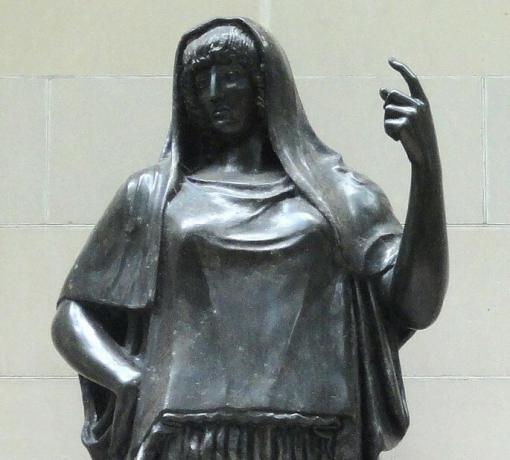
Very sweet and kind, Hestia (or Vesta, for the Romans), she never married and remained a virgin, even with the advances of Poseidon and Apollo.
She was not involved in the political plots and conflicts on Mount Olympus and can be depicted holding a bunch of flowers.
Read too: greek goddess hestia.
9. Irene: Goddess of Peace
The goddess of peace and spring is Irene. This divinity is also associated with reconciliation and cooperation.
This is a mythological character who is part of the "Goddesses Hours", a trio of goddesses responsible for the seasons and justice.
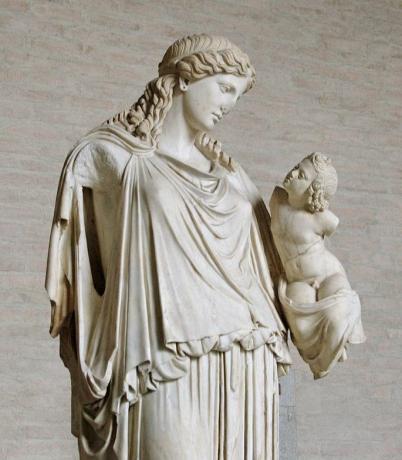
She is the daughter of Zeus and Themis and is symbolized by the cornucopia (a fruit basket made with horns) and a torch.
In Roman mythology, Irene is named Pax.
10. Eos: Goddess of the Dawn
Eos is a deity responsible for the dawn of the day.
The beautiful young woman is the daughter of Hyperion and Téa. Her brothers are Selene (the Moon), and Hélio (the Sun). She is assigned the function of opening the doors of heaven so that her brother can pass through the sunlight and make the light reach Earth.
Thus, she has the power to awaken all beings from her dreams and make the day begin.

One of the stories related to this goddess says that she was very much in love with Titono, a mortal man with whom she had two children.
Saddened by the knowledge that her lover would one day die, she asks Zeus to make him immortal. So it was done. However, she did not ask the man to remain young.
As a result, Titono becomes extremely old and never dies. Eos then asks Zeus to turn him into a cicada.
Eos, which in Roman mythology is called de Aurora, is represented by a woman with long blond hair. In addition, she has wings on her feet and on her back.
You may also be interested:
- Greek gods
- Greek mythology
- What is mythology?



